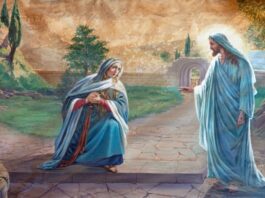
St. Mary Magdalene holds an esteemed position in the Bible, second perhaps only to the mother of Jesus herself. Despite this, she’s often been subject to misconceptions and unfounded stories.
Famously referred to as the “Apostle to the Apostles,” Mary Magdalene was consistently present during significant moments in Jesus’ life. She was among those who supported Jesus and his Twelve Disciples with her resources. Notably, she witnessed Jesus’ crucifixion and the subsequent discovery of his empty tomb. Remarkably, it was she who was first granted the privilege of the awareness of the Resurrection.
Her moniker, ‘Magdalene,’ originated from her residence in Magdala, a Gentile town located in northern Galilee. Despite her Jewish roots, she adopted the culture and manners of a Gentile, due to her surroundings.
A persistent myth in the Church inaccurately identifies Mary Magdalene as the unnamed sinful woman in Luke 7:36-50 who anointed Jesus’ feet. However, modern Scripture scholars highlight the absence of any scriptural evidence to support this mix-up. Mary Magdalene, also known as the one “of Magdala,” is instead recognized as the woman from whom Jesus cast out “seven demons” (Luke 8:2)—suggesting she suffered either from severe demonic possession or, possibly, a grave illness.
Father W.J. Harrington, O.P., in the New Catholic Commentary, asserts that the mention of “seven demons” does not imply Mary’s immoral life, a supposition drawn from incorrectly associating her with the anonymous woman in Luke 7:36. Similarly, Father Edward Mally, S.J., in the Jerome Biblical Commentary, concurs that the western romantic tradition mistakenly identifies her as the sinner in Luke 7:37.
According to pious legend, 14 years after Jesus’ death, St. Mary, along with Sts. Lazarus, Martha, Maximin, Sidonius, her maid Sera, and St. Anne’s body, was put in a boat devoid of sails or oars by the Jews. They drifted to the shores of Southern France. Here, St. Mary spent her remaining years as a contemplative in a cave called Sainte-Baume. Miraculously, she was sustained by the Holy Eucharist, given to her daily by angels as her only nourishment.
At the age of 72, just before her death, she was miraculously transported to St. Maximin’s chapel, where she received the last sacraments.
Editorial credit: Renata Sedmakova / Shutterstock.com
The post Saint Mary Magdalene appeared first on uCatholic.
Daily Reading
Wednesday after Epiphany
Reading I 1 John 4:11-18 Beloved, if God so loved us, we also must love one another. No one has ever seen God. Yet, if we love one another, God…
Daily Meditation
Jesus Passes ByJesús iba a pasar de largo
Click here for daily readings The Word of God is truly living and dynamic and surprises me every time I ponder it. Like the whispers where God says we’ll hear…




